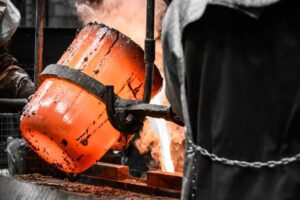Metal microcasting: what it is and what it is about
Ever heard of metal microcasting?
In the world of industrial equipment – we have already seen it with flanges – the processing method is a very important aspect, on which the whole quality of the product is based.
Therefore, investment casting – also called lost-wax casting – is one of the most widely used techniques in the field of metalworking.
But do we really know how it works
METAL MICROCASTING: PRECISION DERIVED FROM CASTING
Microcasting makes it possible to achieve precision in the metal forging process.
This is because it employs casting techniques that take advantage of the properties of certain molds where wax is cast, which are subsequently covered with a ceramic shell.
The shell allows it to withstand the high temperatures that occur in the steel casting process.
The use of the molds makes it possible not only to tolerate the creation of models with small dimensions; but to create shapes with very precise and complex shapes, with the presence of minute reliefs, hollows and very meticulous finishes.
Although when we speak about investment casting we are essentially referring to an industrialized and automated process, there are, however, some manual steps.
The same ones that enable such high standards of precision and forging.
Metal investment casting: lost wax
If we say lost-wax casting, it is because the wax that is lost during processing is collected so that it can be reused in subsequent investment castings.
The molds are shaped following rigid and very precise steps, which are in turn broken down into more minute steps.
Shall we see them together?
It is precisely these steps that are the secret of such clean and meticulous workmanship.
First phase metal investment casting: wax cluster
The preparatory step to the whole metal investment casting process.
Without paying special attention to it, the molds may not meet those particular standards of precision that characterize investment casting.
Needless to say, the casts must perfectly reproduce the characteristics of the product to which they serve as a mold.
For this to happen perfectly, these steps must be respected.
- The wax must be inserted into the molds by injection. In this way, it will repeat the exact shape of the object to be reproduced.
- The small molds should be assembled following a particular treeing, so as to draw a cluster. The treeing is also made of wax: in order for the pieces to weld together to form the cluster, they will undergo a mild casting process.
Second stage of metal investment casting: creation of ceramic shell
Here we come to the creation of the famous ceramic shell.
Ceramic boasts the property of resisting the melting temperature of metals; but in order for this to be in fact so durable, some steps need to be taken.
Having assembled the wax cluster, it must be subjected to several sessions of ceramic baths so as to create a durable ceramic shell.
Dipping and subsequent drying are repeated several times, until it reaches the required thickness.
Once the ceramic shell is perfectly planed, it can be introduced into the kiln at a temperature of 1200-1300°. Before getting there, however, it must be subjected to a lower temperature, so as to melt the wax and reuse it in subsequent processes.
Third stage investment casting process: molten metal on the molds
With the molds ready, we move on to the actual metalworking process.
The metal is poured into the molds and extracted by breaking the ceramic shell.
Again, of course, some care is required.
- The molten metal should be poured immediately after the mold is pulled out. In this way, the heat shock will be low and the cooling curve will be controllable and moderate.
- Once the metal is solidified, shell cracking is carried out. This is done through the use of special techniques and machinery: flexible cutting or flame cutting.
Fourth stage: checks and possible improvements
As precise as the molds are, however, the investment casting process is not enough to give such a neat and precise appearance to the product if it is limited to simply extracting the metal from the ceramic shell.
Therefore, some controls will be needed for finishing and ascertaining standards.
- The product extracted from the molds undergoes cleaning, dimensional grinding, polishing and CNC machining.
- Chemical examination of the metal composition and final packaging and shipping examination is carried out.
- Once the controls are passed, the product is ready for shipment.
Remember that the investment casting process tolerates all kinds of dimensional standards: products starting from a few grams in weight to over 150 kilograms.
ADVANTAGES AND DISADVANTAGES OF INVESTMENT CASTING MACHINING
In terms of precision and finish, the advantages of investment casting machining of metals are undoubted; however, there are some problems related to texture and compactness characteristics, which are not preserved with this machining method.
There is another machining method that, while less precise, keeps these properties intact and that is the hand welding process.
Pantalone’s products
We have briefed you on one of the most widely used machining processes in the field of industrial equipment.
Would you like, now, to take a look at the product catalog of Pantalone SRL?
A vast stock of flanges, pipes and fittings products that have distinguished our business reality.


